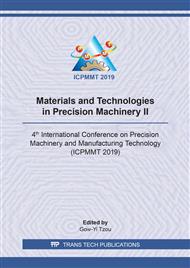p.43
p.53
p.59
p.69
p.77
p.85
p.93
p.101
p.107
The Effect of Thrust Force in Drilling Composite Materials Using a New Step Core-Ball Drill
Abstract:
Compared with conventional metal materials, composite materials can sustain more loads under lower weight and lower space, which is more suitable to use in high strength environment for structure parts application in aerospace, military, transportation and leisure. The enormous aeronautical components and structures of composite materials require assembly and machining. Drilling is the most important making-hole process in the final assembly. However, conventional drill cannot avoid delamination in drilling composite materials effectively depending on tool geometry only. Delamination caused by drilling thrust has been showed as one of the most problematic defects after drilling composite laminates. Drilling of composite plates using a new step core-ball drill (NSCBD), which is a special drill to improve the chip flow and reduces the thrust force (delamination) at the exit of hole, is studied and compared to the traditional step core-ball drill (TSCBD). The thrust force of new step core-ball drill in drilling composite materials was investigated in this study. The theoretical analysis and experimental results show that the NSCBD can improve the thrust force (delamination) and efficiency than TSCBD in drilling composite materials.
Info:
Periodical:
Pages:
77-84
Citation:
Online since:
February 2020
Authors:
Keywords:
Price:
Сopyright:
© 2020 Trans Tech Publications Ltd. All Rights Reserved
Share:
Citation:


